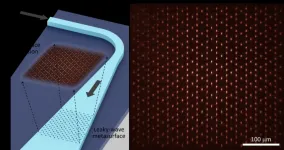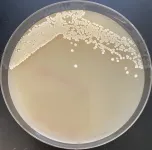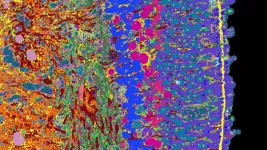(Press-News.org) FINDINGS
Due to a policy decision in 2010 by the U.S. Food and Drug Administration (FDA), the price of a prescription for the therapeutic gout drug colchicine increased nearly 16-fold from $11.25 in 2009 to $190.49 in 2011. Out-of-pocket costs for patients who took the drug jumped more than four-fold from $7.37 to $39.49 over the same period. Use of colchicine dropped 17% during this time and 27% over the following decade. Patients turned to alternative medications for gout such as allopurinol and corticosteroids. However, disease control appeared to worsen, as emergency department use by patients with gout increased by 39.8% and rheumatology doctor visits increased by 10.5% over the following decade.
BACKGROUND
Prior to 2010 the FDA had not formally approved colchicine for any particular clinical condition. That year, however, under its Unapproved Drug Initiative, the FDA approved Colcrys after its manufacturer conducted a clinical trial, and it removed other, much lower-priced, versions of colchicine from the market.
METHOD
The researchers analyzed 2007-2019 data for more than 2.7 million patient-years from MarketScan (IBM), which comprises a large sample of people with either employer-sponsored health insurance or employer-sponsored Medicare supplemental plans.
The researchers note some limitations to the study. They include a lack of a control group, the patient mix could have changed over time, gout severity and functional impairment among patients were not known, possible use of over-the-counter medications such as nonsteroidal anti-inflammatory drugs (NSAIDs) could not be determined, and the findings may not be applicable to people without employer-sponsored health coverage.
IMPACT
The findings of this case study may have implications for other drugs that undergo large price increases and can serve as a useful data point for policies that could affect the price of drugs.
COMMENT
“A rather unique FDA policy resulted in the loss of competitors to colchicine from the market, which led to an enormous increase in its price,” said study lead Dr. Dan Ly, assistant professor of medicine in the division of general internal medicine and health service research at the David Geffen School of Medicine at UCLA. “As a result, use of colchicine dropped. While patients with gout turned to other medications to treat their gout, such medications didn’t do exactly what colchicine did and had different side effects, possibly limiting their use. And therefore it appears, based on the increase in number of emergency department and specialist visits for patients with gout, that their disease control got worse. This case of colchicine speaks to the possible clinical consequences of other policies and manufacturer decisions that result in significant jumps in the prices of other drugs.”
AUTHORS
Additional authors are Mia Giuriato and Dr. Zirui Song of Harvard University
JOURNAL
The study will be published in the peer-reviewed JAMA Internal Medicine
FUNDING
The study was funded by the Director’s Early Independence Award, the National Institutes of Health, and Arnold Ventures.
DISCLOSURE
Song received fees from the Research Triangle Institute for work on Medicare risk adjustment for consultation on legal cases that were not associated with this work.
END
A sharp increase in the price of the gout drug colchicine led to lower use and poorer disease control, UCLA research suggests
The price jump was a result of an unusual FDA policy that eliminated lower-priced alternatives; government policies and manufacturer decisions could similarly affect the price and use of other drugs
2023-05-08
ELSE PRESS RELEASES FROM THIS DATE:
An unprecedented view of gene regulation
2023-05-08
CAMBRIDGE, MA -- Much of the human genome is made of regulatory regions that control which genes are expressed at a given time within a cell. Those regulatory elements can be located near a target gene or up to 2 million base pairs away from the target.
To enable those interactions, the genome loops itself in a 3D structure that brings distant regions close together. Using a new technique, MIT researchers have shown that they can map these interactions with 100 times higher resolution than has previously been possible.
“Using this method, we generate the highest-resolution maps of the 3D genome that have ever been generated, and what we see are a lot of interactions between ...
AI helps create better, simpler hepatitis, COVID-19 tests
2023-05-08
Going beyond pregnancy and COVID-19, the world could someday soon come to rely on at-home tests for many diseases thanks in part to AI-fueled improvements.
University of Florida scientists have used artificial intelligence tools to simplify a test that works for both hepatitis C and SARS-CoV-2, the virus that causes COVID-19. The simplified test happens in one small test tube in just a few minutes. With further refinement, it could come to doctor’s offices soon and, one day, even home tests that are as easy as a pregnancy test.
“We are trying to build a home-based test that is as reliable as a lab-based test,” said Piyush ...
Leaky-wave metasurfaces: A perfect interface between free-space and integrated optical systems
2023-05-08
New York, NY—May 8, 2023—Researchers at Columbia Engineering have developed a new class of integrated photonic devices--“leaky-wave metasurfaces”--that can convert light initially confined in an optical waveguide to an arbitrary optical pattern in free space. These devices are the first to demonstrate simultaneous control of all four optical degrees of freedom, namely, amplitude, phase, polarization ellipticity, and polarization orientation--a world record. Because the devices are so thin, transparent, and compatible with photonic integrated circuits ...
AI predicts future pancreatic cancer
2023-05-08
An artificial intelligence tool has successfully identified people at the highest risk for pancreatic cancer up to three years before diagnosis using solely the patients’ medical records, according to new research led by investigators at Harvard Medical School and the University of Copenhagen, in collaboration with VA Boston Healthcare System, Dana-Farber Cancer Institute, and the Harvard T.H. Chan School of Public Health.
The findings, published May 8 in Nature Medicine, suggest that AI-based population screening could be valuable in finding those at elevated risk for the disease and could expedite the diagnosis of a condition ...
Tiny microbes could brew big benefits for green biomanufacturing
2023-05-08
A research team led by Lawrence Berkeley National Laboratory (Berkeley Lab) and UC Berkeley has engineered bacteria to produce new-to-nature carbon products that could provide a powerful route to sustainable biochemicals.
The advance – which was recently announced in the journal Nature – uses bacteria to combine natural enzymatic reactions with a new-to-nature reaction called the “carbene transfer reaction.” This work could also one day help reduce industrial emissions because it offers sustainable ...
Human Brain Project: Study presents large brain-like neural networks for AI
2023-05-08
In a new study in Nature Machine Intelligence*, researchers Bojian Yin and Sander Bohté from the HBP partner Dutch National Research Institute for Mathematics and Computer Science (CWI) demonstrate a significant step towards artificial intelligence that can be used in local devices like smartphones and in VR-like applications, while protecting privacy. They show how brain-like neurons combined with novel learning methods enable training fast and energy-efficient spiking neural networks on a large scale. Potential applications range from wearable AI to speech recognition and Augmented Reality.
While modern artificial neural ...
Detailed image of the human retina
2023-05-08
What cell types are found in which human tissue, and where? Which genes are active in the individual cells, and which proteins are found there? Answers to these questions and more are to be provided by a specialised atlas – in particular how the different tissues form during embryonic development and what causes diseases. In creating this atlas, researchers aim to map not only tissue directly isolated from humans, but also structures called organoids. These are three-dimensional clumps of tissue that are cultivated in the laboratory and develop in a way similar ...
Welcoming Dr Ece Uzun, MS, PhD as the Editor-in-Chief for JMIR Bioinformatics and Biotechnology
2023-05-08
JMIR Bioinformatics and Biotechnology and JMIR Publications are thrilled to announce and welcome Dr Ece Uzun as Editor-in-Chief for JMIR Bioinformatics and Biotechnology.
Dr. Uzun is currently the Director of Clinical Bioinformatics and Associate Director of Clinical Cancer Informatics and Data Science (CCIDS) at Lifespan and an Assistant Professor of Pathology and Laboratory Medicine at Brown University Alpert Medical School. She has a B.S in Chemical Engineering and M.Sc in Biological Sciences and Bioengineering. She completed her PhD in Chemical Engineering at Northeastern University in 2010 and focused ...
Elucidating the mysteries of enzyme evolution at the macromolecular level
2023-05-08
Professor Nicolas Doucet and his team at Institut national de la recherche scientifique (INRS) made a major breakthrough earlier this year in the field of evolutionary conservation of molecular dynamics in enzymes. Their work, published in the journal Structure, points to potential applications in health, including the development of new drugs to treat serious diseases such as cancer or to counter antibiotic resistance.
As a researcher specializing in protein dynamics, Professor Doucet is captivated by things that are invisible to the naked eye, yet full of mysteries and essential to all forms of life. He studies proteins ...
Recent research advances on historical artifacts and their preservation
2023-05-08
Because we don’t have crystal balls to show us how the world used to look, scientists must rely on preserved artifacts and specimens to provide the details. Below are some recent papers published in ACS journals that have unearthed insights from historic items and provided suggestions for protecting relics. Reporters can request free access to these papers by emailing newsroom@acs.org.
“Two Pathways for the Degradation of Orpiment Pigment (As2S3) Found in Paintings”
Journal of the American Chemical Society
April 14, 2023
Oil paintings created before the 19th century often ...
LAST 30 PRESS RELEASES:
Report on academic exchange (colloquium) with Mapua University
Sport in middle childhood can breed respect for authority in adolescence
From novel therapies to first-in-human trials, City of Hope advances blood cancer care at the American Society of Hematology (ASH) annual conference
Research aims to strengthen the security of in-person voting machines
New study exposes hidden Alzheimer’s 'hot spots' in rural Maryland and what they reveal about America’s growing healthcare divide
ASH 2025: Study connects Agent Orange exposure to earlier and more severe cases of myelodysplastic syndrome
ASH 2025: New data highlights promise of pivekimab sunirine in two aggressive blood cancers
IADR elects George Belibasakis as vice-president
Expanding the search for quantum-ready 2D materials
White paper on leadership opportunities for AI to increase employee value released by University of Phoenix College of Doctoral Studies
ASH 2025: New combination approach aims to make CAR T more durable in lymphoma
‘Ready-made’ T-cell gene therapy tackles ‘incurable’ T-cell leukemia
How brain activity changes throughout the day
Australian scientists reveal new genetic risk for severe macular degeneration
GLP-1 receptor agonists likely have little or no effect on obesity-related cancer risk
Precision immunotherapy to improve sepsis outcomes
Insilico Medicine unveils winter edition of Pharma.AI, accelerating the path to pharmaceutical superintelligence
Study finds most people trust doctors more than AI but see its potential for cancer diagnosis
School reopening during COVID-19 pandemic associated with improvement in children’s mental health
Research alert: Old molecules show promise for fighting resistant strains of COVID-19 virus
Journal of Nuclear Medicine Technology supplement highlights advances in theranostics and opportunities for growth
New paper rocks earthquake science with a clever computational trick
ASH 2025: Milder chemo works for rare, aggressive lymphoma
Olfaction written in bones: New insights into the evolution of the sense of smell in mammals
Engineering simulations rewrite the timeline of the evolution of hearing in mammals
New research links health impacts related to 'forever chemicals' to billions in economic losses
Unified EEG imaging improves mapping for epilepsy surgery
$80 million in donations propels UCI MIND toward world-class center focused on dementia
Illinois research uncovers harvest and nutrient strategies to boost bioenergy profits
How did Bronze Age plague spread? A sheep might solve the mystery
[Press-News.org] A sharp increase in the price of the gout drug colchicine led to lower use and poorer disease control, UCLA research suggestsThe price jump was a result of an unusual FDA policy that eliminated lower-priced alternatives; government policies and manufacturer decisions could similarly affect the price and use of other drugs




